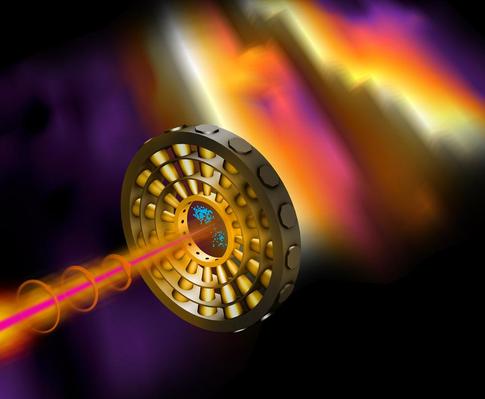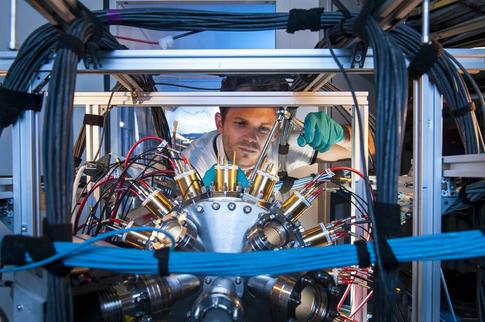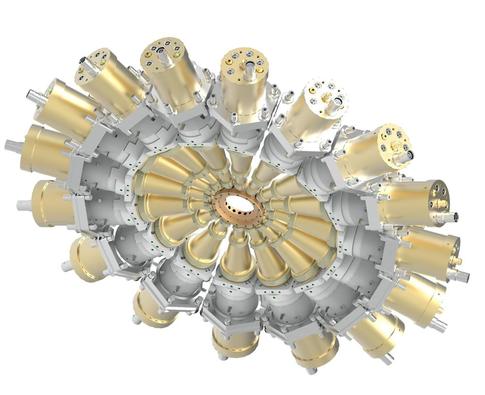XFEL: Entering the realm of attosecond X-ray science
Entering the realm of attosecond X-ray science

ultrashort X-ray pulses (pink) at the Linac Coherent Light Source ionize neon gas at the center of a ring of detectors. An infrared laser (orange) sweeps the outgoing electrons (blue) across the detectors with circularly polarized light. Scientists read data from the detectors to learn about the time and energy structure of the pulses, information they will need for future experiments. Copyright: Terry Anderson / SLAC National Accelerator Laboratory
European XFEL produces unfathomably fast X-ray pulses that are already being used by scientists to explore the unchartered territory of the atomic and molecular cosmos. Intense X-ray pulses lasting only a few femtoseconds - or a few millionths of a billionth of a second - are being used to reveal insights into the dynamics of chemical reactions and the atomic structures of biological molecules such as proteins and viruses. And while there is much more to discover in this femtosecond time range, scientists are already looking to take European XFEL to the next time dimension, exploring reactions and dynamics that occur on an even briefer time scale – the attosecond time regime.
If you leave the shutter of your camera open for too long while photographing a race, the resulting pictures will only be a smear of colour. To capture clear and sharp images of the athletes’ movements you need to make sure the shutter is only open for the shortest time; in fact the best shutter speed to capture a clear snapshot of the runners’ legs frozen in action would be faster than the time the runner needed to move their legs. Good light conditions help too to make sure your photos are sharp and in focus. And so it is as scientists attempt to take snapshots of some of nature’s fastest processes such as the movements of electrons within atoms and molecules. To capture snapshots of these movements in action we need pulses of intense X-rays that reflect the timescale on which these reactions occur – and these reactions can occur even down to the attosecond timescale.
XLEAP
Attosecond X-ray science is expected to allow scientists to delve even deeper into ultrafast chemical and molecular processes and the tiniest details of our world than already possible. But how to produce X-ray flashes that are even shorter than the already ultrafast femtosecond flashes? One of the methods currently being explored by scientists is ‘X-ray Laser-Enhanced Attosecond Pulse generation’ (XLEAP). The method, being developed at the SLAC National Accelerator Laboratory in the USA, is expected to be possible with only moderate modifications to the layout of existing FEL facilities. If successful, the usually chaotic time and energy structure of XFEL (X-ray Free-Electron Laser) pulses, consisting of a sequence of many intensity spikes based on the so-called SASE (Self-Amplification by Spontaneous Emission) principle, can be reliably narrowed down to one single, coherent intensity spike of only few hundreds of attoseconds. In a recent review article in the Journal of Optics, European XFEL scientists propose how the XLEAP method might be implemented at the SASE 3 branch of the facility, eventually providing attosecond pulses for experiments.

European XFEL scientist Markus Ilchen working on the original angle resolving time-of-flight spectrometer at PETRA III, DESY. Copyright: European XFEL
Angular Streaking diagnostics
While the free-electron laser technology is almost ready to provide attosecond pulses, another hurdle is to actually prove and characterize their existence. Experiments to date at XFEL facilities have often relied on indirect measurements and simulations of X-ray pulses to calibrate results. However, only with detailed information from direct measurements of the exact time and energy structure of each X-ray pulse, can X-ray science enter a new era of time resolved and coherence dependent experiments.
With this in mind, a novel experimental approach was conceived as part of an international collaboration including scientists from SLAC, Deutsches Elektronen-Synchrotron (DESY), European XFEL, the Technical University of Munich, University of Kassel, University of Gothenburg, University of Bern, University of Colorado, University of the Basque Country in Spain, and Lomonosov Moscow State University in Russia. In a study published in the journal Nature Photonics, the international group demonstrated the capability of a so-called ‘angular streaking’ method to characterize the time and energy structure of X-ray spikes. The scientists used the shortest pulses available at the Linac Coherent Light Source (LCLS) at SLAC in the USA for their experiment. Using the new angular streaking diagnostic method, millions of pulses, each of a few femtoseconds in length, were successfully captured and analyzed. “Being able to get the precise information about the energy spectrum, as well as the time and intensity structure of every single X-ray pulse is unprecedented” explains Markus Ilchen from the Small Quantum Systems group at European XFEL, one of the principal investigators of this work. “This is really one of the holy grails of FEL diagnostics” he adds enthusiastically.
The new angular streaking technique works by using the rotating electrical field of intense circularly polarized optical laser pulses to extract the time and energy structure of the XFEL pulses. Interaction with the XFEL pulse causes atoms to eject electrons which are then strongly kicked around by the surrounding laser field. Information about the electron’s exact time of birth is not only imprinted in the energy of the electron but also in the ejecting angle. This all provides a ‘clock’ by which to sort the resulting experimental data. Pulses generated by the SASE process, as implemented at European XFEL and SLAC, are intrinsically variable and chaotic. Some of the recorded pulses during the experiment at SLAC were, therefore, already single spikes in the attosecond regime which then were fully characterized for their time-energy structure.

An illustration of the ring-shaped array of 16 individual detectors arranged in a circle like numbers on the face of a clock. An X-ray laser pulse hits a target at the center and sets free electrons that are swept around the detectors. The location, where the electrons reach the “clock,†reveals details such as the variation of the X-ray energy and intensity as a function of time within the ultrashort pulse itself. Copyright: Frank Scholz & Jens Buck, DESY
Angle resolving time-of-flight spectrometer
The underlying spectroscopic method is based on an angle resolving time-of-flight spectrometer setup consisting of 16 individual spectrometers aligned in a plane perpendicular to the XFEL beam. These are used to characterize the X-ray beam by correlating the electrons’ energies and their angle dependent intensities. An adapted version of the spectrometer setup originally developed at the PETRA III storage ring at DESY, was built in the diagnostics group of European XFEL and provided for the beamtime at SLAC.
At European XFEL the diagnostic goal is that scientists will eventually be able to use the method to extract all information online during their experiments and correlate and adjust their data analysis accordingly. Furthermore, although the method has so far only been designed and tested for soft X-rays, Ilchen and his colleagues are optimistic that it could also be used for experiments using hard X-rays. “By reducing the wavelength of the optical laser, we could even resolve the few hundreds of attosecond broad spikes of the hard X-ray pulses here at the SASE 1 branch of European XFEL” Ilchen says.
Time-resolved experiments
During the experiment at SLAC the scientists also showed that it was even possible to use the acquired data to select pulses with exactly two intensity spikes with a variable time delay between them. This demonstrates the capability of FELs to enable time-resolved X-ray measurements attosecond to few femtosecond delay. “By determining the time duration and distance of those two spikes, we can sort our data for matching pulse properties and use them to understand how certain reactions and processes have progressed on an attosecond timescale” explains Ilchen. “Since our method gives us precise information about the pulse structure, we will be able to reliably reconstruct what is happening in our samples by producing a sequence of snapshots, so that much like a series of photographs pasted together makes a moving film sequence, we can make ‘movies’ of the reactions” he adds.
From principle to proof
Due to the limited pulse repetition rate currently available at most XFELs, however, moving from a proof-of-principle experiment to actually using specifically structured pulses for so-called pump-probe experiments requires a large leap of the imagination. European XFEL, however, already provides more pulses per second than other similar facilities, and will eventually provide 27,000 pulses per second, making the dream of attosecond time-resolved experiment a real possibility. “Although, currently, no machine in the world can provide attosecond X-ray pulses with variable time delay below the femtosecond regime in a controlled fashion,” says Ilchen, “the technologies available at European XFEL in combination with our method, could enable us to produce so much data that we can pick the pulse structures of interest and sort the rest out while still getting enough statistics for new scientific perspectives.”
Further reading:
News from SLAC - "Tick, Tock on the ‘Attoclock’: Tracking X-Ray Laser Pulses at Record Speeds"
Original publications:
Attosecond time–energy structure of X-ray free-electron laser pulses
N. Hartmann et al., Nature Photonics, 5 March 2018 doi:10.1038/s41566-018-0107-6
Overview of options for generating high-brightness attosecond x-ray pulses at free-electron lasers and applications at the European XFEL
S. Serkez et al., Journal of Optics, 9 Jan 2018 doi:10.1088/2040-8986/aa9f4f
